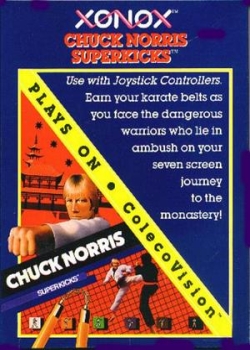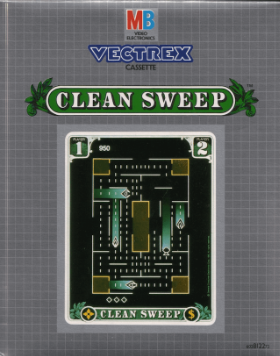| Killer Bees! | |
|---|---|
 | |
| Designer(s) | Robert S. Harris |
| Platform(s) | Odyssey 2 |
| Release | 1983 |
| Genre(s) | Action |
| Mode(s) | Single-player, multiplayer |
Killer Bees! is an action video game written by Robert S. Harris for the Magnavox Odyssey2 and published in 1983.
| Killer Bees! | |
|---|---|
 | |
| Designer(s) | Robert S. Harris |
| Platform(s) | Odyssey 2 |
| Release | 1983 |
| Genre(s) | Action |
| Mode(s) | Single-player, multiplayer |
Killer Bees! is an action video game written by Robert S. Harris for the Magnavox Odyssey2 and published in 1983.
Art Levis for Electronic Fun with Computers & Games said "Here's a game that has great play value, doesn't involve the shopworn space or maze cliches, is graphically vivid and has great sound effects – yet only an eccentric handful of games players will ever know its joysticks". [1]

M.U.L.E. is a multiplayer video game written for Atari 8-bit computers by Ozark Softscape. Designer Danielle Bunten Berry takes advantage of the four joystick ports of the Atari 400 and 800 to allow four-player simultaneous play. Published in 1983, M.U.L.E. was one of the first five games from new company Electronic Arts, alongside Axis Assassin, Archon: The Light and the Dark, Worms?, and Hard Hat Mack. It is primarily a turn-based strategy game, but incorporates real-time elements where players compete directly as well as aspects that simulate economics.

Qix is a 1981 puzzle video game developed by husband and wife team Randy and Sandy Pfeiffer and published in arcades by Taito America. Qix is one of a handful of games made by Taito's American division. At the start of each level, the playing field is a large, empty rectangle, containing the Qix, an abstract stick-like entity that performs graceful but unpredictable motions within the confines of the rectangle. The objective is to draw lines that close off parts of the rectangle to fill in a set amount of the playfield.

Time Zone is a multi-disk graphical adventure game written and directed by Roberta Williams for the Apple II. Developed in 1981 and released in 1982 by On-Line Systems, the game was shipped with six double-sided floppy disks and contained 1,500 areas (screens) to explore along with 39 scenarios to solve. Produced at a time when most games rarely took up more than one side of a floppy, Time Zone is one of the first games of this magnitude released for home computer systems. Ports were released for Japanese home computers PC-88, PC-98 and FM-7 in 1985.

Gorf is an arcade video game released in 1981 by Midway Manufacturing, whose name was advertised as an acronym for "Galactic Orbiting Robot Force". It is a fixed shooter with five distinct levels, the first of which is based on Space Invaders and another on Galaxian. The game makes use of synthesized speech for the Gorfian robot which taunts the player, powered by the Votrax speech chip. Gorf allows the player to buy two additional lives per quarter before starting the game, for a maximum of seven lives.

Chuck Norris Superkicks is a video game produced by Xonox in 1984. It was later sold as Kung Fu Superkicks and Super Kung Fu when the license for the use of the name Chuck Norris expired. The game was produced for the Commodore 64, VIC-20, Atari 2600, and ColecoVision as part of Xonox's double-ender cartridge line.

Buck Rogers: Planet of Zoom, known as Zoom 909 in Japan, is a pseudo-3D rail shooter released as an arcade video game by Sega in 1982. The player controls a spaceship in a third-person perspective, adapting the three-dimensional perspective of Sega's earlier racing game Turbo (1981) for the space shoot 'em up genre. It uses the Buck Rogers license, referencing the space battles, though Buck himself is never seen.
Robert S. Harris, nicknamed RoSHa, is an American designer and programmer who created several 1980s home computer and console games, including War Room and Killer Bees!.

Big Bird's Egg Catch is a video game for the Atari 2600 developed by Atari, Inc. and Children's Computer Workshop and published by Atari in 1983.

Advanced Dungeons & Dragons is an Intellivision game and was one of the first Advanced Dungeons & Dragons games to be licensed by TSR, Inc. It was later retitled to Advanced Dungeons & Dragons: Cloudy Mountain to distinguish it from the sequel, Advanced Dungeons & Dragons: Treasure of Tarmin. It is the first Intellivision cartridge to use more than 4K of ROM.

Cosmic Ark is an Atari 2600 game designed by Rob Fulop and published by Imagic in 1982. The objective is to gather specimens from different planets in a spaceship which contains the survivors from the city of Atlantis. There are two versions of the cartridge. One allows the player to toggle the starfield display with the Black & White / Color TV switch. In the other the starfield cannot be disabled.

Cosmic Avenger is a scrolling shooter developed by Universal and released as an arcade video game in July 1981. It is part of the first wave shooters with forced horizontal scrolling which followed Konami's Scramble and Super Cobra from earlier in the year. It was released the same month as Vanguard. The final installment in Universal's Cosmic series, players take control of the Avenger space fighter and, as in Scramble, use bullets and bombs against enemy air and ground forces. The world is one continuous level made up of different areas.

Clean Sweep is a maze game, released for the Vectrex home game console. It was written by Richard Moszkowski.

Microsoft Flight Simulator, commonly known as Microsoft Flight Simulator 1.0, is a flight simulator video game, released in November 1982 for the IBM PC. It is the first release in the Microsoft Flight Simulator series.

Mazogs is a maze video game developed by Don Priestley and published for the ZX81 by Bug-Byte in 1982. It was subsequently licensed by Softsync and published in the US for the Timex Sinclair 1000.

Heads Up Action Soccer is a video game developed by General Consumer Electronics for the Vectrex console and published in 1983. Heads Up was only the second sports title from GCE, after the football game, Blitz!

Sorcerer's Apprentice is a video game for the Atari 2600, based on a sequence from the film Fantasia.

Night Mission Pinball is a pinball simulation video game published by Sublogic in 1982. It was developed by Bruce Artwick for the Apple II, then ported to the Atari 8-bit computers, Commodore 64, and IBM PC.

Guadalcanal Campaign is a 1982 computer wargame developed by Gary Grigsby and published by Strategic Simulations, Inc. (SSI). It was Grigsby's first released game and has been cited as the first monster wargame made for computers.

The Blade of Blackpoole is an adventure game written for the Apple II by Tim Wilson and published in 1982 by Sirius Software. It was ported to the Atari 8-bit computers, Commodore 64, FM-7, PC-88, PC-98.

Looping is an action game developed and published in arcades in 1982 by Video Games GmbH in Europe and Venture Line in North America. The player controls a plane across two phases in order to reach a docking station by destroying a terminal base or a rocket base to open a gate while avoiding obstacles along the way.